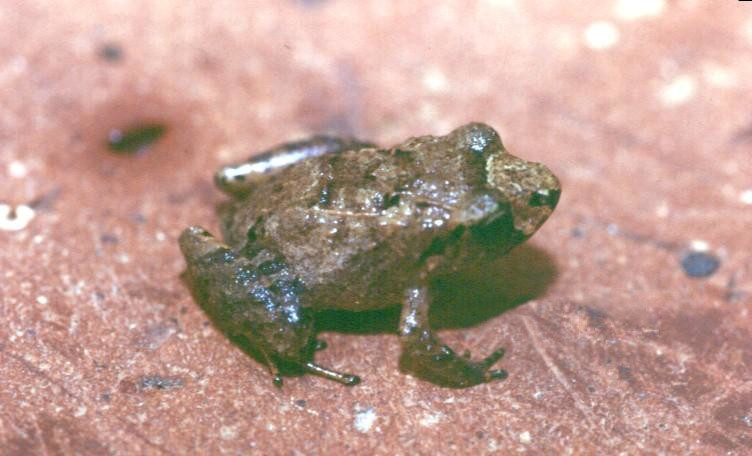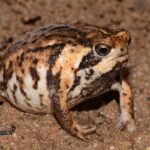Ischnocnema parva: Discovering the Secret Lives of Brazil’s Subtle Forest Singer#
Deep within the lush, verdant forests of Brazil lies an inconspicuous yet fascinating creature—Ischnocnema parva. Often overlooked due to its diminutive size, this remarkable frog harbors secrets that captivate the curiosities of biologists and nature enthusiasts alike. Though small enough to perch unnoticed amidst a tangle of moss-covered roots and leaf litter, Ischnocnema parva embodies the astounding adaptability and fragile beauty integral to our planet’s ecosystem. Also known simply as a member of the litter frog family, this tiny amphibian plays an influential yet understated role in its forest environment.
Picture yourself walking quietly through the subtropical Atlantic Forest under the dappled shade of towering trees. Stepping carefully, you pause occasionally, senses keenly alert to the subtle buzz, chirps, and whispers of life surrounding you. Amidst this tapestry of sound, an enchanting chorus emerges, gently mistaken at first for rustling leaves or gentle raindrops against foliage. It is here, camouflaged among fallen leaves and decaying wood, that Ischnocnema parva makes its home. With an enigmatic song and elusive nature, this small frog reveals itself only through patient observance, rewarding the watchful eye with a glimpse into its delicate world.
Taxonomy and Classification#
Belonging to the family Brachycephalidae and genus Ischnocnema, the species Ischnocnema parva illustrates the diversity and complexity of Brazil’s amphibian fauna. First formally described by Antonio Luiz Augusto Lutz in 1958, this frog shares lineage among about 35 described frogs within its genus, many of which exhibit similar cryptic coloration and habits. “Parva,” derived from Latin, translates directly as “small,” reflecting succinctly its most distinguished characteristic—its impressive minuscule size.
Members of this genus are notable for their direct-developing eggs, bypassing entirely a free-swimming tadpole stage—an adaptive evolutionary innovation that allows survival in terrestrial habitats void of standing water bodies. Closely related species include Ischnocnema verrucosa and Ischnocnema guentheri, both of which share comparable morphology and ecology yet vary slightly in their physical characteristics and vocalizations.
Natural Habitat#
Like many litter-dwelling amphibians, Ischnocnema parva selects habitats characterized by consistently humid substrates, abundant decaying organic matter, and sheltered canopies. Native exclusively to Brazil, the species resides primarily within the Atlantic Forest biome—a region rich in biodiversity but severely threatened by human activity. From the dense and mist-shrouded coastal rainforests of Espírito Santo to the subtropical foothills and humid slopes of Minas Gerais and Rio de Janeiro, its populations gently persist in scattered pockets.
The subtle microhabitats it prefers reflect a meticulous evolutionary adaptation perfectly suited to life among the leaf litter. Rather than residing in visible pools or streams like many amphibians, Ischnocnema parva adopts terrestrial existence meticulously adapted to woodland floors and understory vegetation. Within this shaded world of mushrooms, decaying bark, and damp moss, the frog finds refuge, moisture, shelter from predators, and an ample supply of prey.
Sensitively tuned to microclimatic variation, these frogs thrive best in untouched forest remnants that maintain consistent humidity levels and undisturbed ecological integrity. The Atlantic Forest—once sprawling, now fragmented by agriculture, urban encroachment, and logging—highlights the frog’s vulnerability. Even minor habitat disruptions dramatically impact the availability of crucial territory, illustrating how intricately intertwined Ischnocnema parva’s fate is tied to the health and preservation of its rapidly vanishing forest home.
Physical Characteristics#
At first glance, Ischnocnema parva might appear unremarkable due to its modest size, usually measuring around 14 to 18 millimeters in adult males, and slightly larger in females. However—look closely, let your gaze linger upon its subtle, natural camouflage—and a world of spotless evolutionary design unfolds before you.
The dorsal surface of Ischnocnema parva features muted earth-tones ranging from olive greens and shades of gray to subtle reddish-browns occasionally dappled with darker patterns or subtle streaks. These patterns blend seamlessly with the fallen leaves and twigs covering the forest floor. Its skin often carries a slightly granular texture, aiding further in its cryptic lifestyle. While its belly and undersides are usually a pale cream shade, a close observer will notice these frogs’ incredible facility to sit motionless, almost entirely indistinguishable from their surroundings.
The subtle adornments of natural camouflage serve an essential purpose—allowing the frog to evade hunting snakes, birds, and small mammals. Its limbs are slender yet powerful, enabling efficient movement across the forest floor’s uneven terrain and quick and agile leaps away from danger. These tiny frogs possess proportionally large eyes adapted for nocturnal or crepuscular activity, letting them navigate and hunt with impressive accuracy, even under the forest’s dim and shadowy conditions.
Behavior and Life Cycle#
The fascinating behavior of Ischnocnema parva unfolds quietly and unobtrusively, echoing the understated beauty typical of nature’s smaller wonders. Primarily nocturnal, they spend daylight hours tucked securely beneath leaves, logs, or amidst dense vegetation, emerging with the twilight’s gentle caress to hunt and communicate.
Ischnocnema parva, despite its delicacy, embodies considerably efficient predatory instincts. They feed mainly upon tiny arthropods such as ants, beetles, mites, springtails, and spiders, effectively regulating these insect populations within the ecosystem. Usually lying in patient ambush, they swiftly and precisely capture prey with their quick tongues or sudden leaps, demonstrating commendable decisiveness that defies their diminutive stature.
Mating and Reproduction#
Deriving remarkable advantage from terrestrial adaptation, breeding behaviors differ starkly from aquatic-dependent frog species. Vocalization is critical for these frogs—males serenade potential mates with soft, rhythmic calls resonating among densely packed leaf humus and low vegetation. Each male adopts a favored territory, occasionally interacting vocally with neighboring males through subtly nuanced call exchanges, establishing delicate yet defined territories.
A captivating aspect of Ischnocnema parva’s reproduction is direct egg development. Rather than depositing eggs in water to develop as tadpoles, females carefully lay a small clutch of eggs beneath bark or amid moist leaf litter, protecting them within safe terrestrial niches. These eggs undergo direct embryonic development, bypassing an aquatic tadpole stage—an extraordinary adaptation that frees the frog from dependence on aquatic environments, critical to its survival in this terrestrial ecosystem.
Ecological Role#
In the intricate tapestry of the Atlantic Forest ecosystem, Ischnocnema parva plays a subtle yet vital role. As voracious feeders on arthropods, these tiny meals contribute significantly to the regulation of forest-floor insect populations. Diligently consuming countless insects and spiders, they safeguard a delicate ecological equilibrium essential to ecosystem health.
Likewise, their diminutive size means they frequently become prey to snakes, birds, and small mammals. In this chain of hunters and hunted, Ischnocnema parva represents an essential link—supporting predator species higher up the food chain.
Threats and Conservation Status#
Unfortunately, a combination of forest fragmentation, habitat loss, climate change oscillations, agricultural encroachment, and pollution threaten to disrupt this delicate balance and endanger Ischnocnema parva’s populations. Currently classified as Least Concern by the IUCN Red List—a status reflective primarily of shared habitat with broader protected areas—caution remains necessary as expanding threats persist.
Encouraging protection and restoration of Atlantic Forest remnants, coupled with raising public ecological awareness, emerges as fundamental to safeguarding remaining populations of this enchanting frog.
Cultural and Scientific Significance#
Rarely recognized culturally, Ischnocnema parva nevertheless embodies scientifically valuable attributes, offering insights into amphibian terrestrial evolutionary adaptation and serving as an indicator species whose presence correlates directly to forest health and humidity. Studying its biology, behaviors, and ecological requirements enriches scientific understanding and informs conservation strategies benefiting numerous species sharing their delicate forest niche.
Conclusion: Cherishing the Tiny Forest Guardians#
Though small and subtle, Ischnocnema parva symbolizes resilience, diversity, and interconnectedness in Brazilian ecosystems. Preserving this forest-dwelling amphibian ensures the longevity and vitality of countless species, from insects to larger predators, bound together within the fragile threads of our world’s ecosystems. With awareness, advocacy, and responsible practices, we can safeguard this tiny, charming frog’s future, preserving the gentle chorus resonating beneath Brazil’s starry forest canopy. Consider learning, advocating, and supporting local and international conservation efforts devoted to protecting the unique home of this remarkable amphibian—the Ischnocnema parva.















